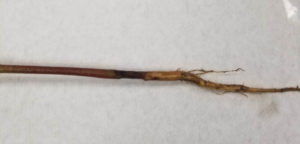Caused by: Rhizoctonia solani Symptoms: Sore shin in cotton is exhibited by sunken reddish-brown lesions near the soil line extending up into the hypocotyl of the seedling. Lesions will progress in growth until girdling of the stem occurs, which causes the seedling to collapse. Overall stunting in seedling growth is also common before lesions become visible. Diagnostic note: Unlike black root rot, seedlings that are infected with Rhizoctonia solani are usually unable to recover from infection. Seedlings will either experience post-emergence damping off or will be completely girdled by lesions. If the stem is observed under a hand lens, brown fungal growth may be observable in the lesions at certain points in the disease cycle. Yield Loss Estimate: Rhizoctonia solani is 1 of 4 cotton seedling pathogens known to cause the cotton yield losses in Tennessee. Often, there is not just one disease that is causing the yield loss. Therefore, when totaling yield losses due to cotton seedling disease, all 4 pathogens are considered. In 2018 alone, it is estimated that 162,000 bales of cotton were lost to seedling disease in the United States. This is the equivalence of 48.6 million dollars lost. Table 1 demonstrates where seedling disease has ranked over the past 5 years for disease loss estimates in cotton across the U.S. In Tennessee, cotton seedling diseases can be great cause of concern. Together, these diseases compose the biggest disease problem Tennessee cotton producers encounter during a growing season. Since 1995, seedling diseases have caused from 3%-22% within the state. Yield losses were typically higher in years with cool and wet conditions present early on in the season.
Cultural Practices: Producers can rotate crops each growing season to help control the severity of R. solani infections. When applicable, leaving fields fallow for 1-2 growing seasons will also help. In addition to crop rotation and fallowing, planting time should also be delayed until the soil temperature is at least 65°F. Seed Treatments: Seed treatments are the first line of defense when combating seedling diseases. When buying seed look for high quality seed that has a base fungicide treatment applied. For R. solani, look for a seed treatment that contains Prothioconazole, Myclobutanil, and/or Penflufen.
